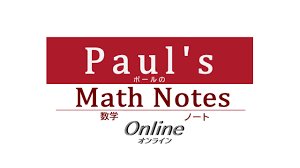
Modern Mathematics
Mathematics is a subject with a rich history stretching back thousands of years. The journey from early numerical methods to the sophisticated branches of mathematics we study today is marked by remarkable discoveries and visionary mathematicians. One modern resource that reflects centuries of mathematical progress is Paul’s Online Math Notes, a widely used learning tool for students around the world.
To truly appreciate the clarity and depth offered by such modern educational resources, it helps to explore the evolution of mathematical ideas during the crucial period from 1080 to 1850. This period bridges the gap between ancient knowledge and the foundation of modern mathematical concepts that form the core of today’s curricula. This article explores key mathematical advancements, influential figures, and the development of ideas that underpin the topics covered in resources like Paul’s notes.
Mathematics in the Medieval Period: Preserving and Extending Ancient Knowledge (1080–1300)
The period between 1080 and 1300 was characterized by the preservation and translation of classical mathematical works. After the fall of the Western Roman Empire, much of Greek and Roman knowledge was lost in Europe but survived in the Islamic world. Islamic scholars translated and expanded upon these works, preserving critical mathematical texts.
One of the most influential figures of this era was Muhammad ibn Musa al-Khwarizmi, whose works in the 9th century introduced systematic algebraic methods and the concept of algorithms. His book, Al-Kitab al-Mukhtasar fi Hisab al-Jabr wal-Muqabala, is where the term “algebra” originates, marking a pivotal moment in mathematical history.
The transmission of this knowledge to Europe occurred mainly through translations from Arabic to Latin, notably in centers such as Toledo, Spain. European scholars gained access to fundamental texts including Euclid’s Elements, Ptolemy’s Almagest, and works by Archimedes. These translations reignited interest in geometry, arithmetic, and astronomy, sparking the slow but steady revival of scientific inquiry.
Mathematics during this time was often studied in the context of the quadrivium—arithmetic, geometry, music, and astronomy—which formed the foundation of medieval education. The use of Hindu-Arabic numerals gradually replaced Roman numerals in Europe, making calculations easier and more efficient. This transition was critical to advancing mathematical thought.
The Renaissance Awakens Algebra and Geometry (1300–1600)
The Renaissance, beginning in the 14th century, was a vibrant period of cultural and intellectual renewal that deeply affected mathematics. With the invention of the printing press in the 15th century, mathematical texts became more widely available. Scholars no longer depended solely on hand-copied manuscripts, accelerating the dissemination of new ideas.
One of the standout achievements was the development of symbolic algebra. Prior to this, algebraic problems were often written in verbose sentences. François Viète introduced a notation system using letters to represent unknowns and constants, making algebraic manipulation more straightforward and generalizable. This innovation paved the way for the algebraic techniques we use today.
Additionally, this era saw the fusion of algebra and geometry through the work of René Descartes. In his La Géométrie (1637), Descartes introduced the concept of representing geometric curves using algebraic equations, effectively creating analytic geometry. This breakthrough allowed mathematicians to analyze geometry using algebraic methods, laying the groundwork for calculus and modern mathematics.
The Renaissance also cultivated a more scientific approach to problem-solving, emphasizing observation, experimentation, and mathematical proof. Mathematicians began to apply their work to physics and engineering, contributing to the broader Scientific Revolution.
The Birth of Calculus and Mathematical Analysis (1600–1700)
The 17th century is often described as the golden age of mathematics, largely due to the invention of calculus, an essential branch of mathematics that deals with change and motion. Independently, Isaac Newton and Gottfried Wilhelm Leibniz developed calculus in the late 1600s.
Newton’s Principia Mathematica (1687) presented calculus as a tool to describe planetary motion, gravity, and other physical phenomena. Leibniz, meanwhile, developed a systematic notation for derivatives and integrals, many of which remain in use today. The introduction of limits, derivatives, and integrals fundamentally changed mathematics, providing powerful tools for scientists and mathematicians.
At the same time, advances in probability theory were made by Pascal and Fermat, initially to solve gambling problems. This nascent field would grow into a vital mathematical discipline with applications in statistics, finance, and science.
Mathematical rigor also began to take shape during this century. Mathematicians increasingly focused on establishing proofs and logical foundations for their work, a trend that would intensify in subsequent centuries.
Mathematical Formalism and the Rise of Abstract Theories (1700–1850)
Between the 18th century and mid-19th century, mathematics became more structured and formal. Mathematicians concentrated on abstract structures and general theories rather than isolated problems. This formalism laid the foundations for many modern mathematical fields.
One of the most prolific mathematicians of this era was Leonhard Euler. Euler made groundbreaking contributions across nearly every mathematical discipline—calculus, graph theory, number theory, and mechanics. His ability to communicate complex ideas clearly influenced generations of mathematicians and educators.
Another towering figure was Carl Friedrich Gauss, whose contributions to number theory, algebra, statistics, and geometry have had lasting impact. Gauss’s work on the method of least squares advanced statistical analysis, while his Disquisitiones Arithmeticae remains a classic in number theory.
During this period, new mathematical objects and ideas emerged. The concept of a function was formalized, abstract algebra began to develop, and the foundations of group theory were laid by mathematicians such as Évariste Galois. These abstractions would become central in 20th-century mathematics and are extensively covered in Paul’s Online Math Notes.
Moreover, the development of rigorous calculus concepts continued with mathematicians like Augustin-Louis Cauchy and Karl Weierstrass, who formalized limits, continuity, and convergence — essential ideas in mathematical analysis.
The Influence of This Era on Today’s Mathematics Education
The centuries from 1080 to 1850 formed the backbone of modern mathematics. Without the translation and preservation efforts in medieval times, the symbolic and analytic innovations of the Renaissance, or the rigorous foundations laid during the scientific revolution and 18th century, our understanding of mathematics would be far less developed.
Today’s math curricula rely heavily on the topics born in these eras: algebra, geometry, calculus, probability, and abstract structures. Resources such as Paul’s Online Math Notes distill this vast heritage into accessible explanations, tutorials, and practice problems, helping students build on this historical knowledge.
Paul’s notes cover a wide array of subjects including algebra, calculus, differential equations, and linear algebra — all topics with roots that trace back through this history. His clear presentation and systematic approach echo the centuries-long evolution of mathematical rigor and clarity.
Conclusion: A Living Tradition in Mathematical Learning
Mathematics is a dynamic and evolving discipline grounded in a rich historical tradition. The period from 1080 to 1850 encapsulates the transformation from preserved ancient knowledge to the formal, symbolic, and abstract mathematics that form the foundation of modern study.
The legacy of mathematicians like Al-Khwarizmi, Viète, Descartes, Newton, Euler, and Gauss lives on, not only in their discoveries but in how those discoveries are taught and learned today. Modern tools such as Paul’s Online Math Notes serve as a bridge between centuries of mathematical evolution and the students seeking to understand these concepts in the 21st century.
Understanding this historical context enriches one’s appreciation of mathematics and highlights the continuity of human inquiry and education—a tradition that continues to inspire learners worldwide.






